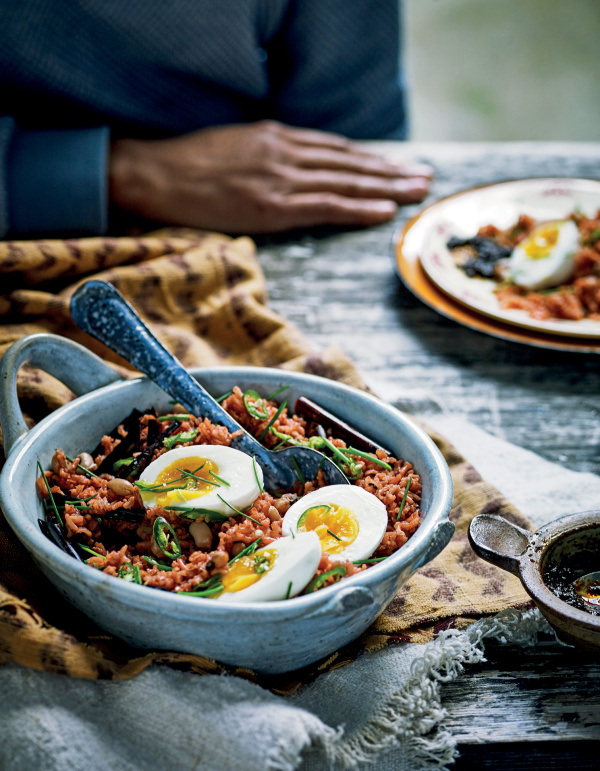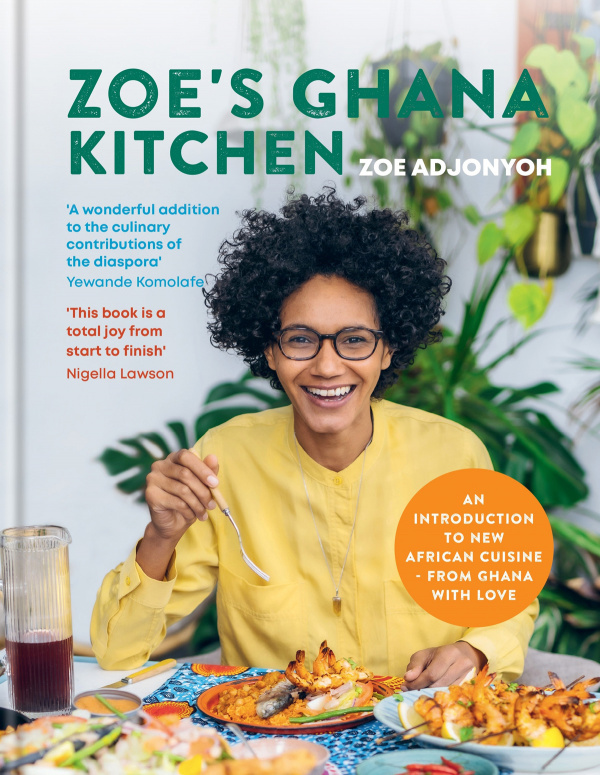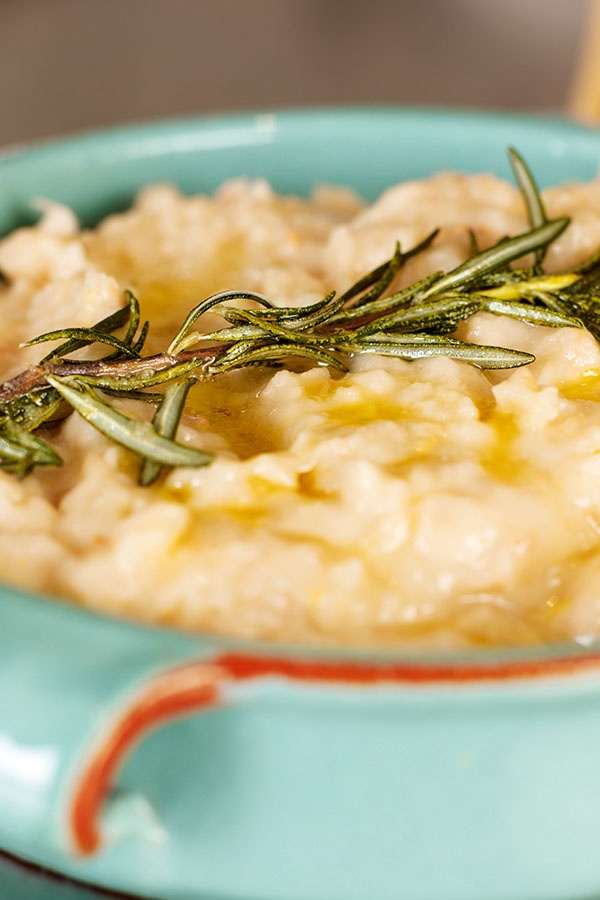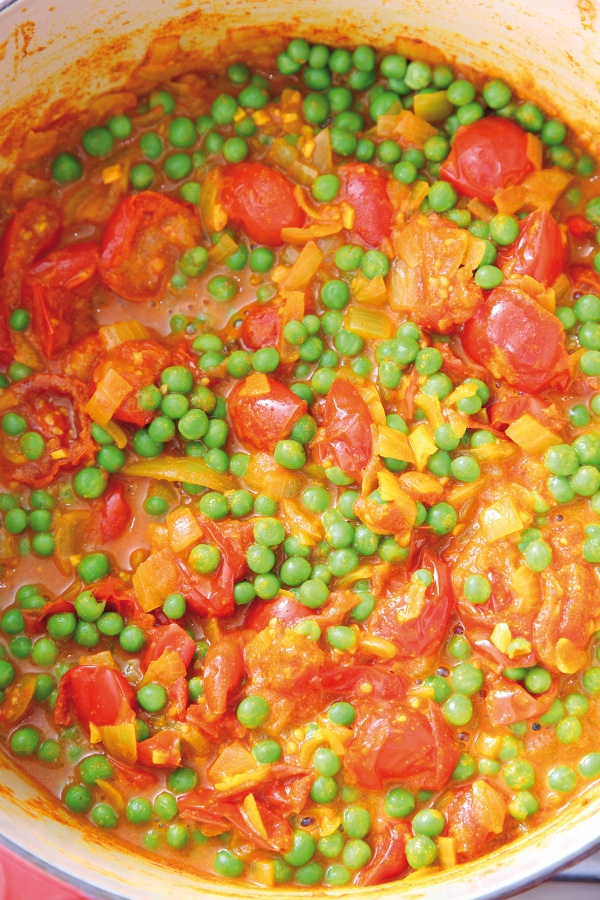Waakye Rice
by Zoe Adjonyoh, featured in Zoe's Ghana Kitchen Published by Mitchell BeazleyIntroduction
In the Caribbean they have rice and beans, while in Ghana we have waakye (pronounced ‘waa-che’) rice — an incredibly popular breakfast and brunch. You can see people hurrying to work in the bustle of a steamy Accra morning firmly gripping a polythene bag of waakye. My Uncle Ernest dashes across the road every morning to get his before his household is even awake.
While waakye rice is simple enough to prepare, the dish is layered with a variety of sometimes complicated accompaniments, including the infamous Waakye Stew; Simple Fried Plantain; Shito (Hot Pepper Sauce); spaghetti (or ‘ta-lia’, as it’s commonly called roadside); small chop (salad); gari (fermented, dried and ground cassava); and an assortment of meat or fish.
The dried millet or sorghum leaves used to give waakye its characteristic reddish colour are reputed to offer considerable nutritional benefits and are gluten-free.
In the Caribbean they have rice and beans, while in Ghana we have waakye (pronounced ‘waa-che’) rice — an incredibly popular breakfast and brunch. You can see people hurrying to work in the bustle of a steamy Accra morning firmly gripping a polythene bag of waakye. My Uncle Ernest dashes across the road every morning to get his before his household is even awake.
While waakye rice is simple enough to prepare, the dish is layered with a variety of sometimes complicated accompaniments, including the infamous Waakye Stew; Simple Fried Plantain; Shito (Hot Pepper Sauce); spaghetti (or ‘ta-lia’, as it’s commonly called roadside); small chop (salad); gari (fermented, dried and ground cassava); and an assortment of meat or fish.
The dried millet or sorghum leaves used to give waakye its characteristic reddish colour are reputed to offer considerable nutritional benefits and are gluten-free.

Share or save this
Ingredients
Serves: 4-6 (as a side)
- 225 - 250 grams dried black-eyed beans or 400g (14oz) can organic black-eyed beans or red kidney beans
- 400 grams medium- or long-grain brown rice
- 1 tablespoon coconut oil
- 1 onion (finely diced)
- 3 - 4 millet or sorghum leaves, or 1 teaspoon bicarbonate of soda
- 1 red rocket (Anaheim) chilli, or bird's eye chilli (thinly sliced)
- sea salt
- 1 litre boiling water or good-quality chicken or vegetable stock
TO GARNISH (OPTIONAL)
- 2 soft-boiled eggs (shelled and halved)
- small bunch of chives (finely sliced)
- 1 green chilli (finely sliced)
- 8 - 9 ounces dried black-eyed beans or 400g (14oz) can organic black-eyed beans or red kidney beans
- 14 ounces medium- or long-grain brown rice
- 1 tablespoon coconut oil
- 1 onion (finely diced)
- 3 - 4 millet or sorghum leaves, or 1 teaspoon baking soda
- 1 red rocket (Anaheim) chilli, or bird's eye chile (thinly sliced)
- sea salt
- 1¾ pints boiling water or good-quality chicken or vegetable stock
TO GARNISH (OPTIONAL)
- 2 soft-boiled eggs (shelled and halved)
- small bunch of chives (finely sliced)
- 1 green chile (finely sliced)
Method
Waakye Rice is a guest recipe by Zoe Adjonyoh so we are not able to answer questions regarding this recipe
- I used to soak the beans for 3–4 hours in the traditional way, but who has time for that? You can just rinse the beans, place in a large saucepan, cover with water, bring to the boil, reduce the heat and simmer for at least 1 hour or until the beans are tender enough to be squeezed easily between thumb and forefinger. Drain and set aside. Faster still, use a can of beans — just drain, rinse and drain again.
- Wash the rice in several changes of cold water until the water runs clear — I wash it at least 3 times — then drain.
- Heat a large, heavy-based saucepan. Add the oil and onion and sauté over a medium heat for about 3 minutes or until lightly golden.
- Meanwhile, wash the dried millet or sorghum leaves, if using — swiftly because the colour will start to run as soon as they get wet — and cut them into 7.5–10cm (3–4-inch) pieces.
- Add the rice, beans, leaves, chilli and salt to the onions, tossing slightly. Stir in the measured water or stock (and the bicarbonate of soda, if using). Simmer, covered, for 15 minutes.
- Turn off the heat. Leave to stand, covered, for 15 minutes until the water has been absorbed and the rice is tender.
- Garnish with the soft-boiled eggs, chives and green chilli, if liked, and serve with shito as a side to any meat- or veg-based stew. It’s also great with Kelewele.
- I used to soak the beans for 3–4 hours in the traditional way, but who has time for that? You can just rinse the beans, place in a large saucepan, cover with water, bring to the boil, reduce the heat and simmer for at least 1 hour or until the beans are tender enough to be squeezed easily between thumb and forefinger. Drain and set aside. Faster still, use a can of beans — just drain, rinse and drain again.
- Wash the rice in several changes of cold water until the water runs clear — I wash it at least 3 times — then drain.
- Heat a large, heavy-based saucepan. Add the oil and onion and sauté over a medium heat for about 3 minutes or until lightly golden.
- Meanwhile, wash the dried millet or sorghum leaves, if using — swiftly because the colour will start to run as soon as they get wet — and cut them into 7.5–10cm (3–4-inch) pieces.
- Add the rice, beans, leaves, chilli and salt to the onions, tossing slightly. Stir in the measured water or stock (and the baking soda, if using). Simmer, covered, for 15 minutes.
- Turn off the heat. Leave to stand, covered, for 15 minutes until the water has been absorbed and the rice is tender.
- Garnish with the soft-boiled eggs, chives and green chile, if liked, and serve with shito as a side to any meat- or veg-based stew. It’s also great with Kelewele.
Additional Information
TIPS:
Traditionally this dish is made by simply adding the rice to the pan of already boiling beans and leaves, but I prefer to remove as much of the starchiness from the beans as possible and add onions and fresh chilli. You can remove the leaves before serving, but I like to leave them in, as they give a dramatic flourish to the dish.
TIPS:
Traditionally this dish is made by simply adding the rice to the pan of already boiling beans and leaves, but I prefer to remove as much of the starchiness from the beans as possible and add onions and fresh chilli. You can remove the leaves before serving, but I like to leave them in, as they give a dramatic flourish to the dish.






Tell us what you think
Thank you {% member.data['first-name'] %}.
Explore more recipesYour comment has been submitted.